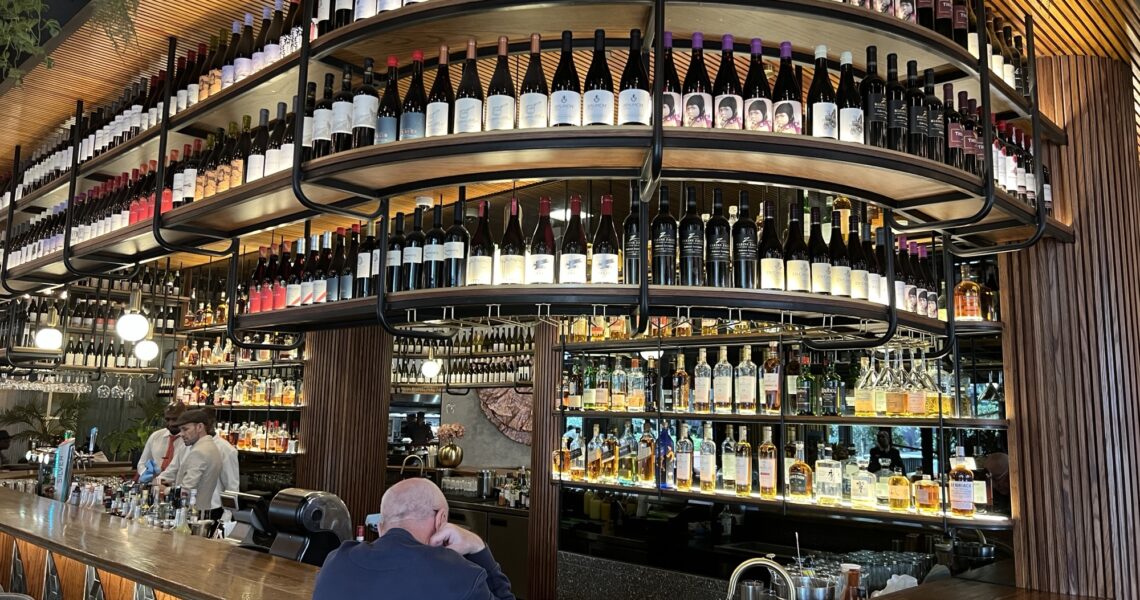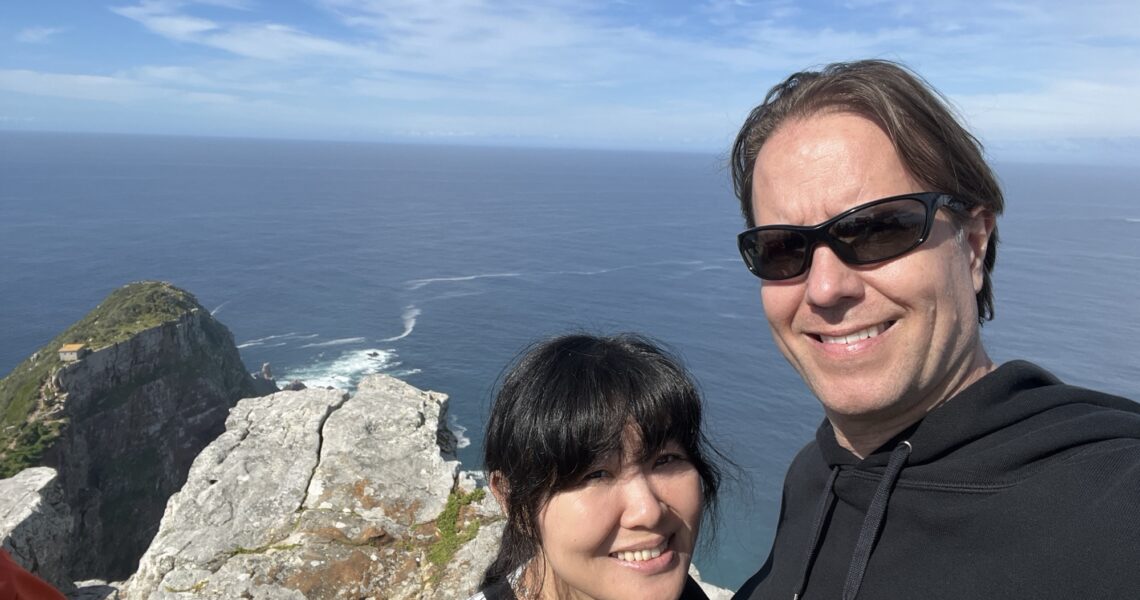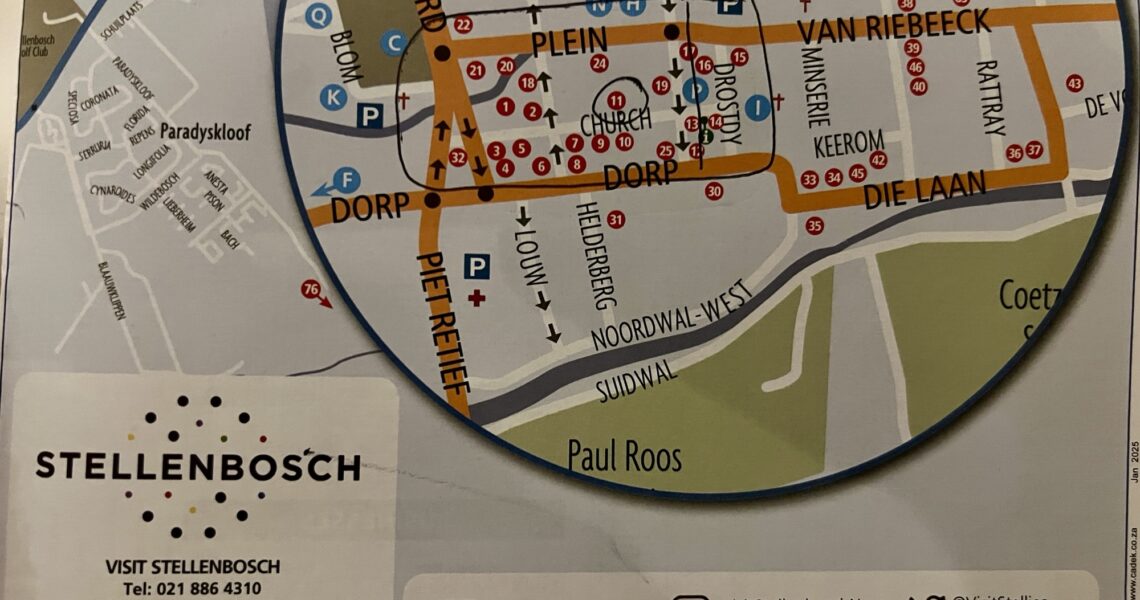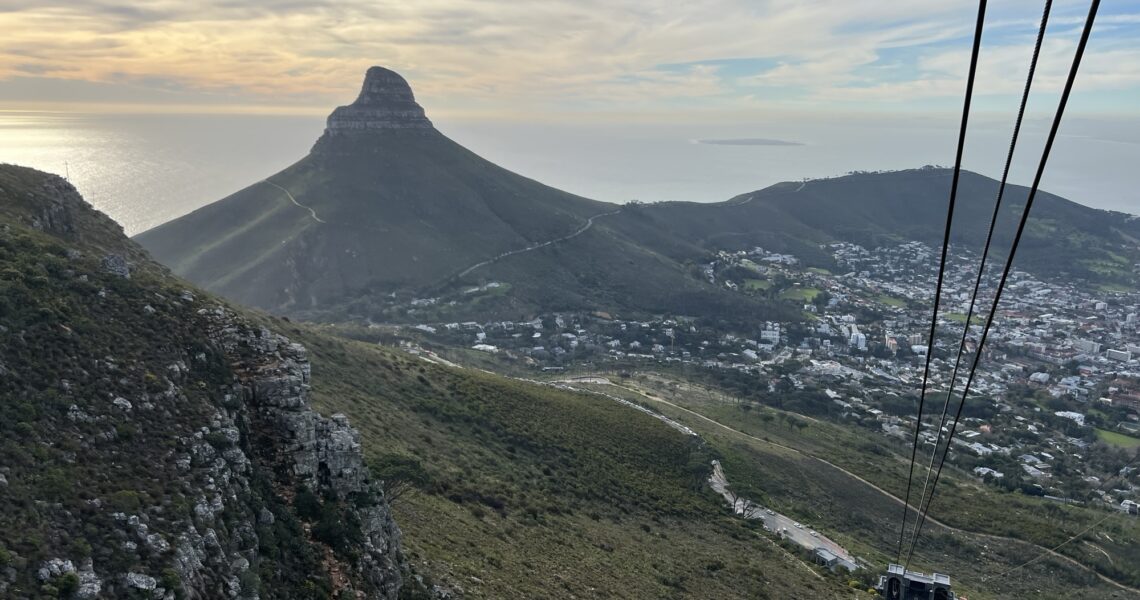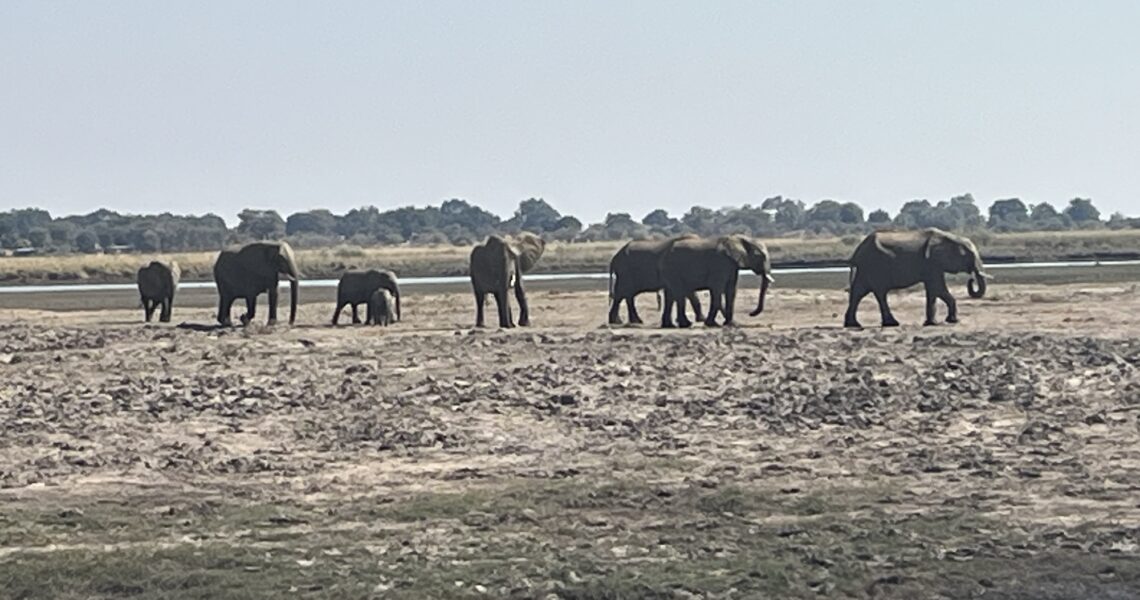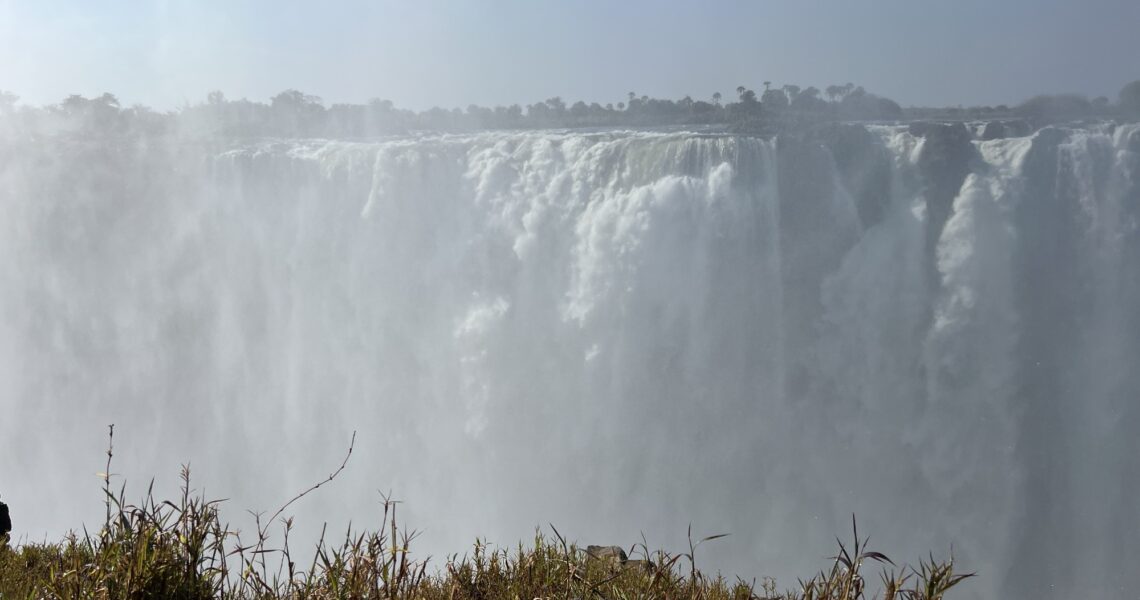Even though we’d have liked nothing more than to sleep in and lounge through the morning we had to get up early to go on a safari. Our hotel was nice enough to arrange an early breakfast for us, and once again the meals were great. We had a frittata with grilled veggies and crispy bacon, and also a poached egg shakshuka. We passed on coffee due to the long drive ahead of us, and as we finished to go brush our teeth we saw someone waiting near the reception desk. They waved at us and we waved back and continued to our room.
Almost immediately there was a knock and it was our tour guide who had just waved at us – they were ready to go. We were told to be ready to depart at 7:20, and it was only 7 am at the moment, but they were eager to get started. We hustled out of there and left by 7:05, so we didn’t affect the schedule.
The car we used was a big comfortable van with air conditioning, and the driver was named Tinashe. This caught Kuniko by surprise because she had arranged the tour with him all the time thinking that he was a she. We drove around to two more places to pick up five more people. The first pair were two American ladies, then we picked up a family of three – a husband, wife and their little daughter. The family seemed to be locals as they knew the driver and guide, and the husband in the family brought a giant bag of drinks in one hand and a six pack of tall beers in the other. It was unclear at first to us whether they were actually tour participants or not, but in the end they were locals who were doing the tour that the tourists usually do.
As soon as we were on the road the dad opened up one of the beers and enjoyed it from the passenger seat up front. Our tour guide’s name was “Wise” and he led a philosophical discussion among the passengers – it was a lot to handle for us that early in the morning. Everyone else seemed to enjoy the conversation, however. Even before we got to Botswana we occasionally passed animals on the side of the road. There were giraffes, impala, and some baboons. We stopped at one red billed bird foraging on the side of the road. Our guide Wise explained to us that the bird lays two eggs every seven years, and determines which of the babies is the strongest, then kills the weak one and concentrates on raising the stronger child. The van became quiet as everyone contemplated this somber fact, and so I took the moment to say, “My mom did the same thing.” It caught everyone by surprise and was one of my best timed jokes ever. Since we were quiet during the philosophy conversation it was a seriously WTF moment for everyone else.
The road from Victoria Falls to the Botswana border is long, straight and full of potholes. The driver earned their salary by avoiding these, but it took about 70 minutes to get to our destination. We got out and lined up to leave the country and walk across the border. The crossing itself was easy and our visa included a 1 day excursion to Botswana so piece of cake. The system was that our guide handed us over to a guy on the Botswana side, and then he ran the show from there. We had to step in a muddy tray of disinfectant (doubt) first, and then walk to the office. Our guide got us through immigration on this side, also an easy check.
In Botswana we rode in an open-sided safari vehicle, seated up high with good views. The guide drove the vehicle through a larger puddle of disinfectant (really?) and after a bathroom break we could load up and get ready to go. Kuniko tried to use the toilet but the door was broken on the stall, so she decided to wait it out. In the safari vehicle we drove about 20 minutes on the open road to get to the park, and it was pretty windy with the open sides! But it was exhilarating to be on the road and getting ready for the adventure.
Our safari was inside the Chobe National Park in Botswana, and we pulled over at the office to check in with the rangers. The dad in our group took the chance to use the toilet – he had been enjoying beer this whole time. The daughter – who I think was named Melle – slept most of the time, but little did we know at the time that she was charging up her batteries to get into trouble later.
Before entering the park, our Botswana guide Tiki cautioned us to be safe, be as quiet as possible around the animals, and that a safari was like fishing and that there were no guarantees that we’ll see animals. All of this was good advice, and then we set off down some bumpy trails in the safari vehicle. Luckily it was 4 wheel drive, and Tiki called the bumping and rocking an “African massage”. You could tell he used this line a lot.
Right off the bat we turned a corner and saw a single elephant pulling up tree roots and enjoying a snack alone. Everyone was taking pictures and taking in the sight. The elephant was not far away at all, and I at least was thinking about which way the driver would go if things went wrong. But the elephant was calm about the whole thing and eventually we moved on. There were so many animals to see – we passed herds of impalas, giraffes, crocodiles, and Kuniko even spotted a zebra that turned tail and walked away. The guide said that zebras were very rare in the park and so we were lucky to see even one. The only picture I got of it was its butt as it walked away.
But maybe even more dramatic than the animals was the beauty of the park itself. The park is huge, right up against Namibia on the other side of the Chobe River. There are high areas and lower ones next to the river that attract plenty of animals when they want water. We passed through many different ecosystems and some of the views across the plains were stunning.
Little Melle – the little daughter of the family – was by now awake and being pretty noisy. She was grabbing things from her parents and other tour members, and screaming when she couldn’t have what she wanted. This caused animals to be scared and move away, causing consternation for the guide and other members of the tour. The mom was pretty embarrassed that she couldn’t control her kid, the dad had completely checked out and was enjoying his fourth beer, and Kuniko and I were both glad we don’t have kids.
We spent around three hours tooling around just a small area of the huge park – roughly the size of a small country. We took a break for a while under a large tree that offered shade, and the driver pointed us to an area behind which he called the “bush bathroom”. Our beer chugging dad walked over to use it, but we were still holding strong. While sipping some sodas provided by our guide we waited patiently for the tour to resume. One odd phenomenon was how quickly we became used to seeing the animals – the single elephant that took our breath away would just a few hours later fade into the background: “Oh, more elephants…” I can’t imagine how the driver must feel every day doing this.
Suddenly our driver hustled us into the vehicle, and we joined some others heading the same direction – someone had spotted some lions.
There was a group of about 10 lionesses, resting in the low savannah grass. Most were sleeping, a few keeping lookout. They were tired from hunting in the evening and being the top of the food chain they had little to fear from taking a cat nap in the afternoon. The drivers of the vehicles approached and slowly encircled the lions, who for their part didn’t really care about us as they were used to this kind of treatment. The passengers of the vehicles were snapping photos like crazy but otherwise everyone was quiet, and even our little troublemaker Melle seemed to realize that it was a good time to keep it down. I was impressed how the drivers all worked together to slowly move the vehicles so that all passengers in all of the cars had an opportunity to get close. At one point I was within a few feet of a sleeping lioness – it would take just one step out of the car and I’d be touching a sleepy killing machine. But they were so cute!
Correctly judging that it was a good time to take a lunch break, our driver took us towards the entrance of the park to leave for lunch. On the way we were stopping by a very large group of elephants staying in the shade of a tree. There were a few babies – they slept lying on the ground while the adults kept watch. I was sort of startled to see that the mother elephant had boobs – they looked oddly human and I guess I wasn’t expecting that. After a short time the elephants all started to move across the road and towards the water – they had the right of way so we just watched them all pass before we could move on.
At the gate once again we took a bathroom break, and the dad got off to empty his bladder – by my estimation he had only one beer left. Once he was back we drove ten minutes out of the park to a safari lodge that was sort of a hotel/restaurant/ rest stop combination. Out front there was a big Baobab tree, and one more in the center of the hotel. I had always wanted to see one in person but didn’t realize they were growing around here.
We pulled into the parking area, and Kuniko was eager to get going and use the (hopefully) clean restroom. However, the mom wanted to change the kid’s clothes, the dad wanted to finish off his last beer before lunch, and the guide wanted us to all stay together. I spoke and said we’d meet them inside, and the guide could see that the rest of the tour members were getting a little fed up with the local family’s antics.
The restaurant was pretty crowded, set up in a buffet style. The food was standard and not that interesting (pasta, meat stew, rice) and the staff looked overworked. For a time they ran out of plates so newcomers couldn’t eat and had to wait around. The restaurant made money on selling drinks, but we just had a light lunch. I held our table and watched people’s stuff while they went to the restroom. Soon the mom came with her daughter and loaded up two huge plates of food – they were making sure they got what they paid for. For a while I sat alone with the mom and kid, who ignored me (possibly sensing our judgement) and powered through the plate of food.
Once the other members got back we chatted a little – the two American ladies were planning to stay in Africa longer. One was going to Cape Town after a few days for sightseeing and winetasting, and the other doing a business conference in Durban. They seemed like nice people, stopping to pray before they started to eat.
After lunch and a little shopping we went outside to ride a boat for the second part of the safari. The cruise was on a small flat boat with lawn chairs set up on top. There was a toilet in the back and a different guide who pointed out the wildlife and sights as we went. The boat was a different way to see animals and from the water you could get quite close to them without scaring them off. The sun was shining down hard on us as we cruised up-river, with the country of Namibia on our right and Botswana on the left. All this water was going to go over Victoria Falls soon – it gave me a sense of the volume going over the falls that we saw yesterday.
While we traveled the family was busy – Mom taking selfies, Dad sleeping off the beers, and little Melle trying to steal the binoculars from one of the American ladies. When she wouldn’t hand the expensive equipment over Melle went into a tantrum again – ugh. She tipped over their lunch leftovers and spilled her soda on her clothes in frustration.
But meanwhile we tuned them out and focused on the animals. We saw many snake birds – named because of their snake-like appearance while swimming. These birds were seen drying off their wings in the sun, sort of ominous but with beautiful colored feathers underneath. We got up close with some Cape buffalo, saw semi-submerged hippos, and even had a chance to see a big group of elephants swimming across the river. Once they made it across all of them (including the babies) proceeded to spray mud and water over themselves, and the babies rolled in it to give themselves a little sunscreen.
As we headed back, a couple of swallows were flying around our boat – sometimes resting on the roof – and they stayed with us for quite a while. We saw many birds on this trip, and everyone agreed that they were some of the most vividly colored and beautiful birds they’d ever seen. I imagine that bird watching might be a popular activity here as well. Everybody was sleepy on the way back – the beautiful weather, cool breezes on the water – it was nice to chill on the boat and enjoy the ride. I looked around and other than the boat captain, Kuniko and I were the only ones still awake. It was a peaceful moment – one of the highlights of the trip for me.
Once we returned to the dock at the restaurant, one of the American ladies tried to get the bar to make a particular cocktail – but it was sort of odd timing and it sounded like the bartender didn’t want to do it. We waited a while for the last trip to the toilet, and the dad came over to me and apologized for falling asleep during the boat ride and all the bathroom breaks. I told him not to worry about it and we bumped fists (maybe only the second time in my life to bump a fist) but I think he knew that their behavior wasn’t the best. But never during the trip were we at all upset – I think mostly we were surprised at how the family was acting and taking it in stride. Nothing could ruin the fun we had during the safari.
So, back in the car – this time a closed air conditioned van – and back to the border. We were not alone, many tours were doing the same thing, and we had to wait a little bit longer in line. The border was super casual, just a matter of formalities, and the Melle was running around playing and causing trouble. She was literally running back and forth across the border while her parents waited in line for processing. Her mom was looking more and more pissed off. I was interested to see that there were very few guards at the border, and I didn’t see any guns. One of the most casual border crossings I’d ever done.
Before leaving I talked with the American ladies about tipping, and they said they planned on giving a tip of about $7 for the driver, and the same for the guide on the other side. Like me they weren’t clear on how much would be expected and how much was covered by our original payment. We tipped the same as them – but I can’t help but feel like the staff had a sort of glum reaction.
On the ride back dad was asleep in the front seat, and the mom was busy negotiating the price of her family with the staff, who originally seemed like her friend but now were in a weird situation. As I listened to the negotiation happening in a combination of English and a local language we passed a long train of baboons that seemed like they were looking for trouble.
When we dropped off the family the mom got out of the car quickly without saying goodbye so I guess she wasn’t happy with how things worked out. We said goodbye to the American ladies, and then the staff dropped us off at our hotel around 6 pm – not too late and a solid day of exploring overall.
We were bushed and bellied up to the bar to order some cocktails. Prices at the resort were not as expensive as I expected – premium/local beers were $5 a pint, with cocktails the same. For dinner we were feeling carnivorous after seeing all those animals so we had a pulled beef croquette for an appetizer, I had a rump steak and Kuniko a large hamburger. After a big glass of red wine with dinner we were ready for bed. There were only about five other couples staying at the resort – and they were just starting to show up for dinner as we left.
The good news was that we’d be able to sleep in tomorrow and enjoy a leisurely breakfast and coffee.

